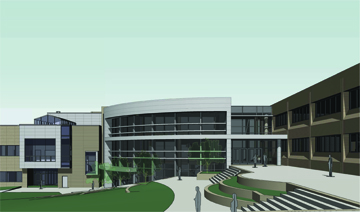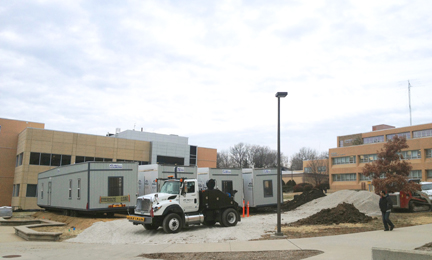Groundbreaking for New Building Will Accommodate Engineering Growth

In its ongoing effort to produce additional high-quality engineers to meet industry demands and boost the state and national economy, the University of Kansas School of Engineering held a formal groundbreaking this fall for new engineering facilities.
The official kickoff event for the Learned Engineering Expansion Phase 2 (LEEP 2) was early in the morning of Friday, Oct. 26, on the lawn west of Eaton Hall near Spahr Library. The $80 million, 140,000-square-foot project consists of two separate buildings, one at the engineering complex and another on KU’s west campus, on the southwest side of the Park and Ride lot. Through the University Engineering Expansion Act of 2011, the Kansas Department of Commerce is providing $35 million for the project. The remaining $45 million will be from a combination of donor gifts through KU Endowment, the KU Center for Research and other university funds, including issuing bonds to finance construction and related costs.
"This is a historic time for engineering education," said JoAnn Browning, associate dean for administration in the School of Engineering. “It is predicted that there will be a significant shortage in available engineering talent in the United States, and this region of the country is already feeling the effects. That is why the engineering community appealed to the state of Kansas to help produce more engineering graduates, and why our enrollments have ballooned recently."

Staff in the School of Engineering has actively encouraged more high school students to pursue degrees in engineering and computing to meet industry needs. Undergraduate enrollment at the School of Engineering this fall is at a record 2,151 students. That includes a 22 percent increase in freshman enrollment from the previous year.
The building to be constructed at the engineering complex will be four stories and 110,000 square feet, located west of Spahr Library, between Learned Hall and the Measurement, Materials and Sustainable Environment Center (M2SEC). It will also extend west to the area currently occupied by Burt Hall.
"The main campus facility will become the keystone for the engineering complex – linking the state-of-the-art research facilities in M2SEC with our traditional Learned and Eaton halls. The new building will serve as the front door for the complex – a welcoming center for new students, a resource for current students,and a launching site for our newest graduates," Browning said.
The facility will have six new classrooms equipped with IT and configurations to support the newest teaching techniques, eight teaching laboratories, four shared research spaces and individual research spaces for new faculty. It will also contain a variety of spaces geared toward helping students succeed in their academic and professional pursuits. That will include the Engineering Career Center, student recruitment and retention services, student meeting rooms and group offices, informal study areas and graduate student offices, with the overarching goal of increasing student retention.
"The student success areas are designed to encourage group collaboration, easy access to tutoring services and graduate teaching assistant office hours, along with convenient and intuitive placement of student recruitment and retention services," she said.
The building on KU’s west campus will house a so-called “high bay facility,” which is designed to provide ample space for research, testing and development of large, structural systems such as concrete piers or steel girder connections for bridges. This 30,000-square-foot building will be used primarily by faculty and students in the Department of Civil, Environmental and Architectural Engineering.
"The new high-bay structural testing facility provides versatile space for large-scale testing of components and systems under large loads and deformations. A 40-foot tall strong wall will enable lateral loading of these systems and position KU to perform structural testing that is currently not possible in the area," Browning said.
There will also be space for a new home for student projects, including groups of engineering students focused on developing sustainable approaches to energy infrastructure and automotive technologies.
"This project will help bolster the School of Engineering in many ways," said Stan Rolfe, interim dean of engineering. "It will provide a state-of-the art learning environment for a growing number of students, space for additional faculty and a home to many of the services essential to recruiting and retaining high-quality engineering and computing students to meet the demands of industry. We are grateful to the state, the university and our donors for their support to make this building a reality."